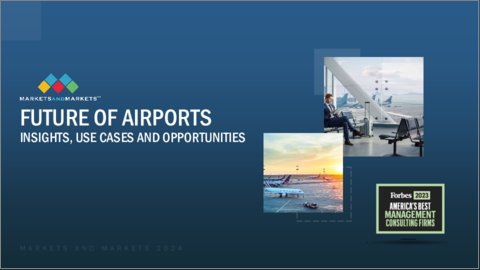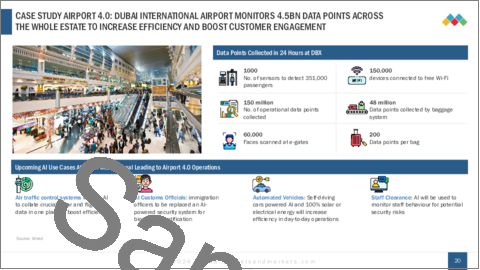|
|
市場調査レポート
商品コード
1453088
空港産業の未来:2030年~Future of Airport Industry to 2030 and Beyond |
||||||
カスタマイズ可能
|
|||||||
| 空港産業の未来:2030年~ |
|
出版日: 2024年03月11日
発行: MarketsandMarkets
ページ情報: 英文 60 Pages
納期: 即納可能
|
全表示
- 概要
- 目次
世界の空港産業への投資額は、予測期間中に14.4%のCAGRで推移し、2021年の2,000億米ドルから、2040年には2兆4,040億米ドルの規模に成長すると予測されています。
旅客と航空機の輸送量の増大は、空港が従来の航空関連の収益以外の革新的な収益源を模索するきっかけとなっています。空港敷地内の小売店、ホスピタリティ業、不動産開発など、航空以外の収益の戦略的拡大は、収益を多様化させるだけでなく、空港運営の財務的安定性を高めます。アーバンエアモビリティ (UAM) インフラの導入は、効率的で持続可能な都市交通ソリューションに対する急増する需要に対応するための先進的なアプローチであり、世界の交通ネットワークの重要な拠点としての空港の役割をさらに強化するものです。
同時に、空港都市 (エアロトロポリス) の確立が空港を多面的な商業・レクリエーションの拠点へと変貌させています。この進化は、空港の経済効果を従来の境界線をはるかに超えて拡大し、地域経済を刺激し、接続性や利便性、アメニティの相乗的な融合によって世界の事業者を魅了するものとなっています。
こうした進展と同時に、認知自動技術の導入が旅客体験に革新をもたらしつつあります。AIとオートメーションの力を活用することで、空港はチェックインから搭乗まで、よりパーソナライズされたシームレスな旅行体験を提供することができます。この技術的飛躍は、業務を合理化し手作業への依存を減らすことで、雇用不足に伴う課題に対処するだけでなく、空港環境の安全性とセキュリティも大幅に向上させます。高度な監視システム、自動化されたセキュリティスクリーニング、脅威検知のための予測分析などは、空港の安全とセキュリティの水準をかつてないレベルにまで高めている技術革新の一つです。
当レポートでは、世界の空港産業の展望を調査し、メタバース技術によって強化されたコグニティブエアポートの台頭、空港都市の戦略的開発、アーバンエアモビリティ (UAM) の統合、自動化による空港運営への動き、ネットゼロエミッションの達成と持続可能性へのコミットメントなどを含む空港の革新的動向をまとめています。
目次
- コネクテッドトラベラー
- 異種の顧客
- 乗客のタイプ
- 乗客の増加
- 5Gエアポート
- コグニティブエアポート
- メタバース
- 空港都市
- モビリティハブ
- 将来のバーティポート
- 収益の推移
- 空港所有権の移行
- 自動化ソリューション
- 将来のスキル
- 主な持続可能空港
- H2ハブとしての空港
Global Airport investment is estimated to reach USD 2,404 billion in 2040 from USD 200 billion in 2021, at a CAGR of 14.4%.
The escalating passenger and aircraft traffic serves as a catalyst for airports to explore innovative revenue streams beyond traditional aeronautical sources. This strategic expansion into non-aeronautical revenues, encompassing retail, hospitality, and real estate developments within airport premises, not only diversifies income but also enhances the financial stability of airport operations. The incorporation of Urban Air Mobility (UAM) infrastructure represents a forward-thinking approach to address the burgeoning demand for efficient, sustainable urban transportation solutions, further augmenting the airport's role as a critical nexus in the global transportation network.
Simultaneously, the establishment of airport cities, or 'aerotropolises', transforms airports into multifaceted commercial and recreational hubs. This evolution extends the economic impact of airports well beyond their traditional boundaries, stimulating local economies and attracting global businesses through a synergistic blend of connectivity, convenience, and amenities.
In tandem with these developments, the deployment of Cognitive Autonomous Technologies is revolutionizing the passenger experience. By harnessing the power of artificial intelligence and automation, airports are able to offer more personalized, seamless travel experiences, from check-in to boarding. This technological leap not only addresses the challenges associated with employment shortages by streamlining operations and reducing the reliance on manual labor but also significantly enhances the safety and security of airport environments. Advanced surveillance systems, automated security screenings, and predictive analytics for threat detection are among the innovations elevating the standards of airport safety and security to unprecedented levels.
Enhancing Passenger Connectivity and Diversity
Modern airports are transforming into vibrant, inclusive gateways that serve an increasingly global and varied passenger base. This transformation is driven by advanced data analytics and digital innovations, which facilitate tailored, high-quality services for every traveler. By leveraging deep insights into diverse passenger profiles, airports are not only boosting their operational efficiencies but also significantly improving the travel experience. This strategic shift ensures that airports are more than just transit points; they are accessible, welcoming spaces for everyone.
Innovating with Cognitive Technologies and Metaverse Applications
The adoption of cognitive technologies and the integration of metaverse platforms represent a groundbreaking evolution in airport operations. These advancements are setting the stage for smarter, more responsive airport environments. Through applications like virtual check-ins and AR-enhanced wayfinding, airports aim to streamline the passenger journey, reducing stress and converting traditionally passive waiting periods into dynamic, engaging experiences. This innovative approach signals a move towards minimizing inconveniences while maximizing passenger satisfaction.
The Emergence of Aerotropolis: Airport Cities Redefined
The development of airport cities signifies a shift towards integrating airports into broader urban and economic ecosystems. These aerotropolises are more than mere points of departure and arrival; they are thriving centers of commerce, leisure, and business. By offering a diverse array of services and amenities, airport cities are becoming landmarks in their own right, contributing to economic growth and attracting global enterprises. This trend not only redefines the airport's role in urban development but also positions it as a key driver of socio-economic progress, bridging the gap between local communities and international networks.
Research Coverage:
The report delves into the future of airports, highlighting the anticipated evolution towards accommodating connected and diverse travelers, the emergence of cognitive airports integrated with the metaverse, the development of comprehensive airport cities, the advancement towards autonomous airport operations, and a strong commitment to sustainability and achieving Net Zero emissions. These pivotal areas of focus are explored in depth, offering stakeholders a clear vision of the innovative transformations set to redefine airport ecosystems worldwide. This forward-looking perspective is aimed at guiding industry participants as they prepare to meet the demands of a rapidly changing aviation landscape.
Report Scope
The comprehensive report provides stakeholders with critical insights into the transformative trends shaping the future of airports, including the focus on serving connected and diverse travelers, the advent of cognitive airports enhanced by metaverse technologies, the strategic development of airport cities, the integration of Urban Air Mobility (UAM), the move towards autonomous airport operations, and the commitment to achieving Net Zero emissions and sustainability. These forward-looking insights are invaluable for airlines, investors, and service providers, highlighting opportunities for operational efficiencies, enhanced passenger experiences, new revenue channels, and environmental stewardship. By embracing these insights, stakeholders can navigate the evolving aviation landscape with confidence, leveraging the report's findings to secure a competitive advantage and align their strategies with the future direction of airport development.
TABLE OF CONTENTS
1. KEY TRENDS TRANSFORMING AIRPORTS TO 2030 AND BEYOND
2. CONNECTED, DIVERSE TRAVELERS
- 2.1 CONNECTED TRAVELERS
- 2.2 HETEROGENOUS CUSTOMERS
- 2.3 PASSENGER TYPES
- 2.4 PASSENGER GROWTH
3. COGNITIVE AIRPORTS
- 3.1 5G AIRPORT
- 3.2 COGNITIVE AIRPORTS
- 3.3 METAVERSE
4. AEROTROPOLIS
- 4.1 AIRPORT CITY
- 4.2 MOBILITY HUB
- 4.3 FUTURE VERTIPORTS
- 4.4 REVENUE SHIFT
- 4.5 AIRPORT OWNERSHIP SHIFT
5. AUTONOMOUS AIRPORT
- 5.1 AUTONOMOUS SOLUTIONS
- 5.2 FUTURE SKILLS
6. NET ZERO AIRPORT
- 6.1 TOP SUSTAINABLE AIRPORTS
- 6.2 AIRPORTS AS H2 HUBS
7. KEY CHANGES BY 2030
8. APPENDIX





